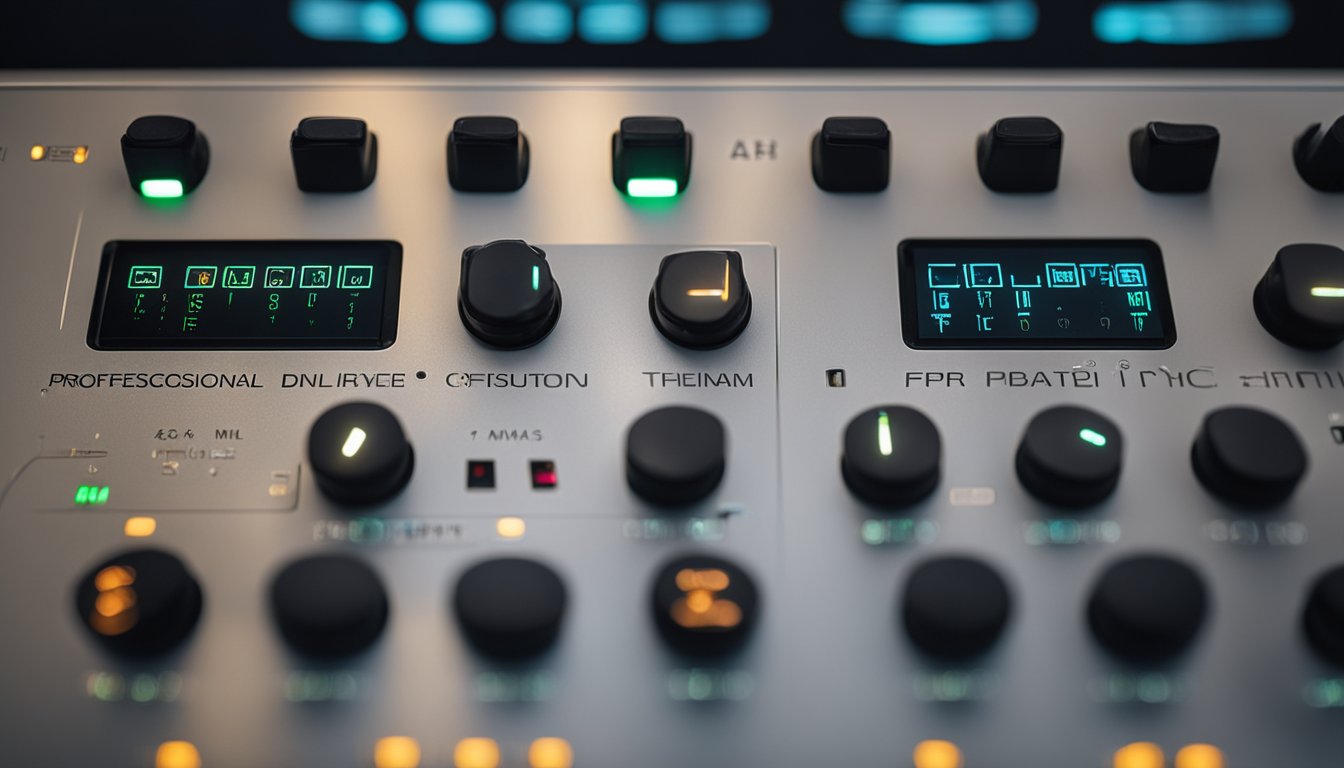Contact
Write to Us And We Would Be Happy to Advise You.
Do you have any questions, or would you like to speak directly with a representative?
By peter
If you have ever used a home appliance, a computer, or a car, you have likely interacted with a membrane control panel. These panels are ubiquitous in modern life and are used to control a wide variety of devices. But what exactly is a membrane control panel, and how does it work?

A membrane control panel is a type of interface that allows a user to interact with a device through a series of buttons or switches. It consists of several layers of material, including a graphic overlay, adhesive spacer, and circuit layer. When a user presses a button, it deforms the overlay, which in turn activates a circuit that sends a signal to the device. The design of a membrane control panel can be customized to meet the specific needs of a device, making it a versatile and cost-effective solution for many applications.

If you have ever used a calculator, remote control, or any device with buttons, you have likely interacted with a membrane control panel. Membrane control panels are a type of user interface that uses a thin, flexible membrane to register user input. They are commonly found in a wide range of industries, from automotive to medical to consumer electronics.
The basic structure of a membrane control panel consists of several layers of materials, including a graphic overlay, adhesive spacer, and circuit layer. The graphic overlay is the top layer of the control panel and features the buttons or icons that the user presses. The adhesive spacer separates the graphic overlay from the circuit layer, which contains the conductive traces that register the user’s input.
One of the benefits of using a membrane control panel is its durability. Since there are no moving parts, membrane control panels can withstand a high number of actuations without failing. Additionally, membrane control panels are highly customizable, allowing designers to create unique shapes, sizes, and button layouts to fit their specific application.
Membrane control panels can be designed with a variety of features, including backlighting, tactile feedback, and waterproofing. Some membrane control panels even use capacitive touch technology, which allows for touchless operation and a sleek, modern look.
Overall, membrane control panels are a versatile and reliable user interface solution that can be customized to fit a wide range of applications. Whether you need a control panel for a medical device, automotive system, or consumer product, a membrane control panel may be the right choice for your application.

When it comes to designing a membrane control panel, you have a lot of options to choose from. The design and customization of your control panel can greatly impact its usability and overall effectiveness. Here are some key factors to consider when designing and customizing your membrane control panel.
The first step in designing a membrane control panel is selecting the right materials. Membrane switches are typically made from polyester or polycarbonate materials, which are durable, flexible, and easy to work with. You’ll also want to consider the type of adhesive used to attach the switch to the panel. Some adhesives are better suited for high-temperature environments, while others are designed to withstand exposure to chemicals and other harsh conditions.
The graphic overlay is the top layer of the membrane switch and is what the user interacts with. It’s important to choose a design that is both visually appealing and functional. You’ll want to consider factors such as color, font, and layout when designing your overlay. It’s also important to ensure that the overlay is easy to read and that the buttons and switches are clearly labeled.
The layout of your buttons and switches is another important factor to consider when designing your membrane control panel. You’ll want to arrange the buttons and switches in a way that makes sense for the user and is easy to navigate. It’s also important to consider the size and shape of the buttons and switches, as well as the amount of force required to activate them.
Overall, designing a membrane control panel requires careful consideration of a variety of factors. By selecting the right materials, designing a functional graphic overlay, and arranging your buttons and switches in a logical way, you can create a control panel that is both effective and user-friendly.

If you are interested in the manufacturing processes of membrane control panels, this section is for you. In this section, we will discuss the three main processes involved in the manufacturing of membrane control panels: screen printing, circuit layer assembly, and die cutting.
Screen printing is a commonly used method in the production of membrane control panels. In this process, a screen is used to transfer ink onto the surface of the membrane. The ink is then cured to create a durable and long-lasting print.
During screen printing, a stencil is created and placed over the membrane. Ink is then applied to the stencil and forced through the mesh of the screen onto the membrane. This process is repeated for each layer of the membrane until the desired design is achieved.
The circuit layer assembly process involves the creation of the conductive traces that allow the membrane control panel to function. This process typically involves the use of conductive inks, copper, and other conductive materials.
The circuit layer assembly process begins with the creation of a substrate, which is typically made of a flexible material such as polyester. The conductive traces are then printed onto the substrate using a variety of printing methods, including screen printing and inkjet printing.
Once the conductive traces are in place, the circuit layer is laminated onto the membrane layer to create a single, integrated membrane control panel.
The final step in the manufacturing process of membrane control panels is die cutting. Die cutting is the process of cutting the membrane control panel to the desired shape and size.
During die cutting, a die is used to cut the membrane control panel into the desired shape. The die is typically made of steel and is custom-made to match the specific design of the membrane control panel.
In conclusion, the manufacturing processes of membrane control panels involve screen printing, circuit layer assembly, and die cutting. Each of these processes is critical to the production of high-quality and durable membrane control panels.
The electrical properties of a membrane control panel are crucial to its functionality. In this section, we will discuss two important aspects of the electrical properties of these panels: conductive materials and circuitry integration.
The conductive materials used in membrane control panels are responsible for carrying the electrical signals from the user’s touch to the device’s processor. Conductive materials used in membrane switches include silver, copper, carbon, and conductive inks. The choice of conductive material depends on the specific application, such as the required voltage, current, and environmental conditions.
Silver is the most common conductive material used in membrane switches due to its excellent conductivity and durability. Copper is also a good conductor, but it is less commonly used due to its tendency to oxidize. Carbon is a less expensive option than silver, but it has a higher resistance and is less durable. Conductive inks are a versatile option that can be printed on various substrates, but they have lower conductivity than metals.
The circuitry of a membrane control panel can be integrated in several ways, such as using a single-sided or double-sided circuit, a flexible or rigid circuit, and a printed or etched circuit. The choice of circuitry integration depends on the specific application, such as the required complexity, size, and cost.
Single-sided circuits are the simplest and most cost-effective option, but they have limited functionality. Double-sided circuits can provide more complex functionality, but they are more expensive. Flexible circuits are useful for applications that require bending or folding, while rigid circuits are useful for applications that require stability. Printed circuits are a cost-effective option for low-volume production, while etched circuits are suitable for high-volume production.
In summary, the electrical properties of a membrane control panel are essential to its functionality. Conductive materials and circuitry integration are two important aspects that must be carefully considered during the design and manufacturing process.
When designing a membrane control panel, there are several user interface considerations that you should take into account. These considerations are essential to ensure that the control panel is easy to use and provides an intuitive user experience.
One of the most critical considerations for a membrane control panel is the tactile feedback. Tactile feedback refers to the physical response that the user receives when they press a button on the control panel. The buttons on a membrane control panel should provide a satisfying tactile response to the user. This feedback can be achieved through the use of snap domes or metal domes, which provide a tactile “click” when the button is pressed.
Visual indicators are another essential consideration for a membrane control panel. These indicators provide the user with feedback on the status of the system. For example, a green LED may indicate that a device is on, while a red LED may indicate that a device is off. Visual indicators can also be used to indicate the status of specific functions or modes.
Another critical consideration for a membrane control panel is environmental resistance. The control panel should be designed to withstand the environmental conditions in which it will be used. This includes resistance to dust, moisture, and other contaminants. The materials used in the construction of the control panel should be selected based on the environmental conditions in which it will be used.
In summary, when designing a membrane control panel, you should consider the tactile feedback, visual indicators, and environmental resistance. These considerations are critical to ensure that the control panel provides an intuitive user experience and can withstand the environmental conditions in which it will be used.
Membrane control panels find applications in a wide range of industries, including medical equipment, industrial machinery, and consumer electronics. They are used to control and monitor production processes, enhance the final product with a tailored decorative appearance, and provide an easy-to-use interface for the user.
Membrane control panels are commonly used in medical equipment, such as patient monitors, diagnostic equipment, and laboratory instruments. They provide a reliable and durable interface that can withstand harsh environments, such as exposure to chemicals, moisture, and frequent cleaning. Membrane control panels are also easy to clean, which is essential in medical environments where cleanliness is critical.
Membrane control panels are used to control and monitor production processes in various manufacturing industries, such as automotive, electronics, and food and beverage. They are also used in industrial equipment, such as machinery controls, process control panels, and factory automation systems. Membrane control panels offer a reliable and durable interface that can withstand harsh environments, such as exposure to chemicals, dust, and moisture.
Membrane control panels are commonly used in consumer electronics, such as remote controls, home appliances, and gaming devices. They provide an easy-to-use interface for the user and enhance the final product with a tailored decorative appearance. Membrane control panels are also cost-effective and easy to manufacture, which is essential in the highly competitive consumer electronics market.
In summary, membrane control panels are widely used in various industries, including medical equipment, industrial machinery, and consumer electronics. They provide a reliable and durable interface that can withstand harsh environments, enhance the final product with a tailored decorative appearance, and provide an easy-to-use interface for the user.
When it comes to membrane control panels, testing and quality assurance are critical to ensure that the product meets the required standards. The following subsections provide an overview of the two essential components of testing and quality assurance.
Performance testing is a crucial step in the production of membrane control panels. It involves testing the product’s functionality, accuracy, and response time. The aim is to ensure that the product meets the required performance standards. Performance testing is done through various methods, including:
Durability assessments are another essential component of testing and quality assurance. The aim is to ensure that the product can withstand various environmental conditions and continue to function correctly over time. Durability assessments are done through various methods, including:
Overall, testing and quality assurance are critical components of membrane control panel production. By ensuring that the product meets the required standards, you can be confident that it will perform as expected and last for an extended period.
When it comes to installing and maintaining your membrane control panel, there are a few key things to keep in mind to ensure optimal performance and longevity. In this section, we’ll cover some of the most important considerations for both installation and maintenance.
One of the most critical aspects of installing a membrane control panel is choosing the right mounting technique. There are several options available, including adhesive mounting, bolt-on mounting, and snap-in mounting. The best option for your particular panel will depend on a variety of factors, including the size and weight of the panel, the type of surface it will be mounted on, and the specific requirements of your application.
Regardless of the mounting technique you choose, it’s essential to follow the manufacturer’s instructions carefully. This will help ensure that the panel is mounted securely and that it will function properly over the long term.
Proper cleaning and care are also critical to maintaining the performance and longevity of your membrane control panel. Routine cleaning can help prevent buildup of dirt, dust, and other contaminants that can interfere with the panel’s functionality. It’s important to use only approved cleaning agents and techniques, as using the wrong products can damage the panel.
In addition to routine cleaning, it’s a good idea to perform regular maintenance checks to ensure that all components of the panel are functioning properly. This might include checking for loose or damaged connections, inspecting the panel for signs of wear or damage, and testing the functionality of any built-in features or controls.
With proper installation and maintenance, your membrane control panel can provide reliable, long-lasting performance for years to come.
Do you have any questions, or would you like to speak directly with a representative?